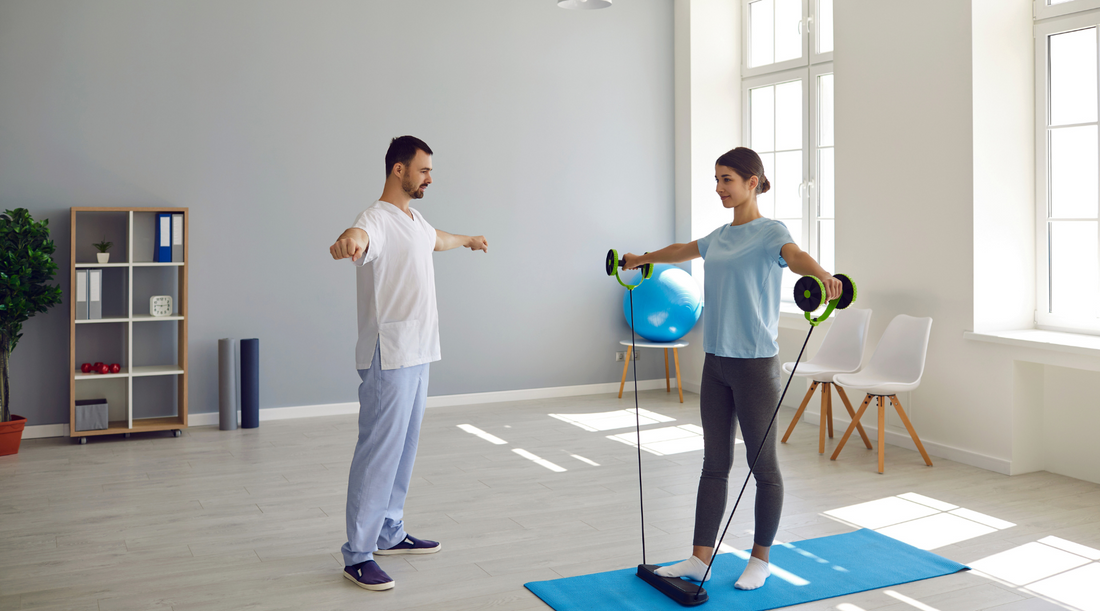Even with top-notch medical professionals, nutritionists, and coaches at their disposal, athletes can still experience injuries. Various factors can contribute to these injuries, and one such factor is inadequate sports injury rehabilitation.
As athletes undergo rehabilitation for common sports injuries, therapists must consider two key hurdles. One is ensuring the full recovery of the injured structure and tissues, and two reconditioning the musculotendinous complex. In the initial stages, therapeutic modalities should encompass activities like stretching, range of motion exercises, gait training, iontophoresis, electrical stimulation, shockwave therapy, PRP, and Amnio therapy among others. Afterward, their routine should shift toward targeted muscle-strengthening exercises specific to their sport, which can be done using resistance bands.
Understanding Sports Injuries

Sports can be magnificent, epic, and inspiring, however, they can also be heart-wrenching and devastating, with injuries being significant contributors.
Despite the enjoyment and fun of sports, an inherent risk of injury exists that cannot be eliminated. Every sport involves a risk of injury due to the physical toll on the body‒ be it through contact collisions, or intense exertion‒ regardless of its level of intensity. While some injuries are minor, leading only brief periods of athletes sidelining others can have lasting repercussions that impact careers in the long run.
Most common sports injuries include
- Shoulder pain or dislocation
- Tennis elbow
- Runner’s knee
- Hip bursitis
- Sprains and strains
- Post-ACL repair
Resistance bands for rehabilitation can aid in strengthening and conditioning injured areas by enabling a gradual progression aligned with the athlete’s recovery stage. These bands prove valuable for isometric exercises, gentle stretches, range-of-motion routines, muscle reinforcement, and enhancing core strength. Frequently, physical therapists and healthcare professionals seamlessly integrate exercise bands into rehabilitation programs.
When Should Rehabilitation Exercises Start Post-Injury?
Rehabilitation exercises can start immediately upon approval from a professional, such as a physical therapist or healthcare provider. Following a comprehensive assessment of your injury, considering its type, severity, and underlying factors, they ensure the rehabilitation plan is meticulously customized to your requirements.
In the initial stages of designing the rehabilitation plan, healthcare professionals may employ exercise bands to evaluate a patient’s strength and range of motion. This evaluation is instrumental in tailoring exercises for the duration of the rehabilitation program.
By incorporating different resistance bands into rehabilitation programs, healthcare professionals offer a flexible and adaptable approach to strength training and functional exercises. This approach not only fosters patient engagement but also facilitates targeted muscle activation, thereby contributing significantly to the overall success of the rehabilitation process.
Stages of Sports Injuries

Early or Acute Stage
The early or acute stage of a sports injury refers to the immediate phase following the occurrence of the injury. This period is marked by the sudden onset of symptoms, including pain, swelling, and inflammation, often stemming from trauma or overuse during sports activities. It is a crucial stage for interventions focused on reducing inflammation, facilitating healing, and preventing complications, setting the groundwork for the subsequent phases of rehabilitation.
In this stage, injury rehabilitation bands can be thoughtfully integrated to offer gentle and controlled exercises that support. These exercises aim to aid the healing process without exacerbating the injury, including activities geared toward controlling swelling (edema) and managing pain.
Second Stage, Subacute, or Intermediate Stage
This phase comes after the acute stage and typically occurs within days to weeks after the injury. During this period, the initial inflammation and swelling start to diminish. Healthcare professionals may initiate a more comprehensive rehabilitation plan, incorporating targeted exercises, manual therapies, and modalities to further facilitate the healing process. The objective is to enhance flexibility, strength, and functional capacity, while closely monitoring the individual’s response to the interventions.
In the subacute stage of injury, healthcare professionals can integrate super exercise bands into a progressive rehabilitation plan. These bands are employed to enhance flexibility and joint mobility, as well as to strengthen muscles and the surrounding areas.
Late, Chronic, or Long-term Stage
The late phase of sports injury is also referred to as the chronic or long-term stage. Following the initial acute and subacute stages, this period extends into the extended recovery or maintenance phases. During this stage, individuals often regain a significant level of function, and the focus shifts toward further enhancing strength, endurance, and sport-specific skills. Rehabilitation at this point typically includes more advanced exercises, intense conditioning, and a gradual reintroduction to full activity or sports participation.
Incorporating workout resistance bands with higher resistance levels becomes pertinent in this stage. Advances in strength training are sports-specific exercises, such as squats, lunges, and rows with resistance bands, which are introduced to challenge muscles in a controlled manner. Athletes may also utilize the bands to replicate the movements and requirements specific to their respective sports.
Why are Resistance Bands Used in Rehabilitation?

Versatility and Adaptability
Resistance bands, also known as fitness bands or stretchy bands are incredibly versatile tools that can be adapted to suit the needs of virtually any individual, regardless, of their fitness level or the nature of their injury. These bands come in various resistance levels, allowing for progressive strengthening as the individual recovers. Whether it is used by a professional athlete or someone recovering from a minor sprain, resistance bands can be customized to your unique requirements.
Targeted Muscle Engagement
One of the key advantages of resistance bands is their ability to provide targeted muscle engagement. This is especially beneficial during rehabilitation, as it allows individuals to isolate specific muscle groups and work on strengthening them. Unlike traditional weights, resistance bands offer constant tension throughout the range of motion, making them ideal for controlled and safe muscle rehabilitation.
Gradual Progression
In injury rehabilitation, gradual progression is paramount. Resistance bands are exceptionally well-suited for this purpose. They enable individuals to start with minimum resistance and gradually increase it as their strength and endurance improve. This gradual approach minimizes the risk of overexertion and re-injury, ensuring a safe and effective rehabilitation process.
Resistance Band Rehabilitation Exercises for Common Sports Injuries
Building Ankle Strength After a Sprain
Sprains can bring about considerable pain, underscoring the importance of initiating appropriate strengthening exercises once you can confidently bear your body weight. Starting with isometric exercises is advised as the initial phase in healing ankle injuries, followed by the integration of heavy-duty bands into the rehabilitation process.
Secure the band around the forefoot of the affected ankle, grasping both ends in your hand. Gradually and gently press your ankle downward as far as comfortable, then return to the starting position. You may repeat this sequence 10 times.
Rehab Exercises for the Knees
Injuries to knees are prevalent not only among athletes participating in various sports but also among the general population. Resistance bands can play a crucial role in enhancing strength and resistance in the affected knee following an injury.
Here’s a knee flexion exercise to aid in recovery. Fasten the workout bands to an anchor close to the door to the floor, or have someone hold the ends securely. Use the opposite end of the band to loop around one ankle while lying on the floor. The band should be taut when your leg is straight. Slowly bend the knee, bringing your foot toward your buttocks, and then gradually return to the starting position.
Recover from Shoulder Injuries
The shoulder is frequently prone to sports-related injuries. To enhance the muscle of the upper back and improve posture, try incorporating the bent-over row exercise.
Position the resistance band with its center beneath your foot. Grasp the ends in your hands, extending your arms straight toward your feet. Allow your elbows to bend outward behind your body, and gradually pull upwards. Return to the starting position and repeat the movement.
The fundamental principles of sports injury rehabilitation remain consistent, regardless of the nature of the injury athletes endure. Although utilizing resistance bands in rehabilitation, undoubtedly expedites the healing process, the crucial factor in injury rehabilitation, regardless of the tools and exercises employed, is seeking the assistance of healthcare professionals.
Start your Recovery Journey with Supper Exercise Bands

Resistance bands have often been overlooked gems in gym equipment, discreetly hanging on hooks, ready to give your muscles a satisfying ache (in the best sense). Not only are they a vital asset for any gym setup, but they’re also cost-effective and portable. Toss your resistance band into your bag, and you can carry it wherever you please, ensuring you never miss a workout session.
Resistance bands have undergone numerous transformations since their inception. Invented by Gustav Gosswiler in 1895, these bands first found application in rehabilitation training during the early 20th century. Over subsequent decades, trainers continue to use them for recovery and rehabilitation purposes. And with scientific research influencing their development, these bands have become essential tools for health professionals in facilitating recovery.
Different resistance bands are available, and it’s crucial to select one with the appropriate resistance level. Explore the color-coded resistance bands offered by Super Exercise Bands, a reliable provider that offers bands with various resistance levels. Additionally, enhance the versatility of your bands by considering accessories, available for purchase alongside the bands. Optimize your savings by investing in sets or bulk resistance bands.
Integrate resistance bands into your rehabilitation regimen to facilitate a more efficient recovery process and enhance your overall performance.
The content provided on this blog is for informational purposes only and is not intended as professional medical advice. The information shared here should not be used to diagnose or treat any health problems or illnesses without consulting a qualified healthcare
professional. Always seek the advice of your physician or other qualified healthcare provider with any questions you may have regarding a medical condition. Never disregard professional medical advice or delay in seeking it because of something you have read on this blog. Reliance on any information provided by this blog is solely at your own risk.

